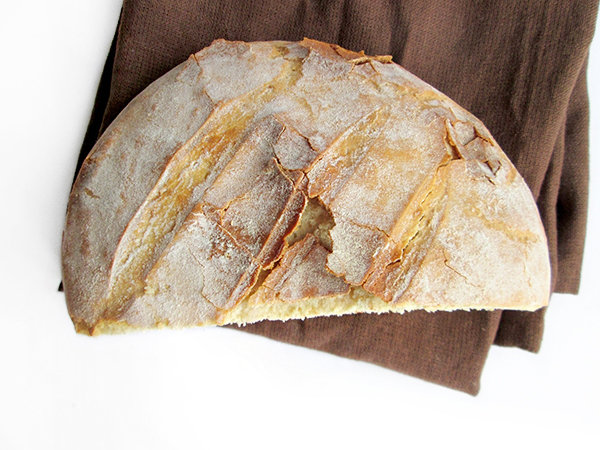Sourdough starter is the way to cultivate the wild yeast in a form that can be used for baking. Wild yeast is present in flour in general, so to make a starter, it is sufficient simply to combine flour and water and let it ferment for a few days. After a few days, bubbled form on the surface, the smell starts to be stronger and the yeast is ready to be used. The initial starter takes some time to ferment, so using a regular store-bought yeast seems like an easier thing to do. But the flavour and texture a loaf of bread can get from wild yeast are so unique, they are almost incomparable to the goods made with regular yeast.

Ingredients:
For the starter
300 grams plain flour
300 ml warm water
For the sourdough loaf
350 grams plain flour
200 grams sourdough starter
150 ml warm water
1 teaspoon salt
Preparation:
To make the starter, combine a third of the flour and water in a container. Mix the batter vigorously with a wooden spoon, until smooth. Scrape down the sides with a rubber spatula and cover the container loosely with plastic wrap. Put the container somewhere where the temperature is not too high and let it sit, undisturbed, for 24 hours.
On the second day, there should be a few bubbles on the surface of the starter. At this point, the starter should smell somewhat sweet, and a bit yeasty. Again add (the second third of) the flour and water, stir vigorously until blended into a smooth batter. Scrape the sides again, cover loosely with plastic wrap, and return to the same spot for another 24 hours. Repeat the process next third day, using up the remaining 100 grams of flour and 100 ml of water.
On the fourth day, the starter should have almost doubled, and looking quite frothy. It should smell really sour and be ready to use. Sift the flour and reserve about 100 grams. Take 200 grams of the starter, add the majority of the sifted flour, salt and half of the water, and mix well with a wooden spoon. Start mixing the dough, adding a little water at the time, until the dough forms.
Put a good amount of reserved flour on the work surface, transfer the dough and knead with your hands for about 10 minutes, adding reserved flour as you knead. After the kneading, the dough should be smooth and elastic. Lightly oil a large bowl, tip the dough in and cover with a kitchen towel. Let it rise in a warm spot for five hours, or until doubled. After the dough has risen, knead it on a lightly floured surface until smooth, roll into a round loaf and lightly dust it with flour. Put the dough on a baking sheet lined with baking paper and let it rise for 4 more hours (up to overnight).
When ready to bake, tap the baking sheet gently on the counter to shake off some of the flour off the loaf, and bake in a preheated oven at 220˚C (425˚F) for 20 minutes, then lower the heat to 180˚C (350˚F) and bake for 10-15 more minutes. Let it cool and serve.
Note: Cover the rest of the starter tightly and place it in the fridge. Take it out and feed it (in the same fashion, equal parts of water and flour) at least once a week.

Plus one from me; a lovely simple guide to sourdough.
ReplyDeleteThanks! :)
DeleteDivno izgleda :)
ReplyDelete